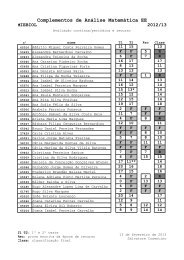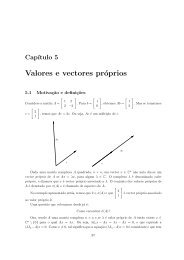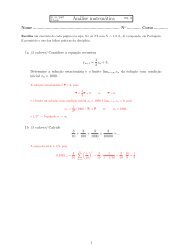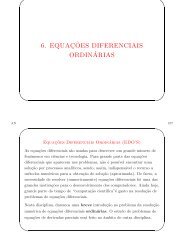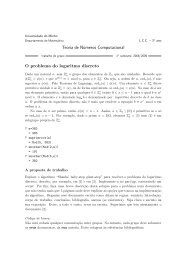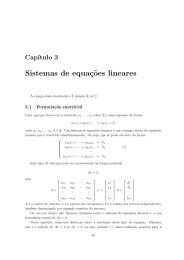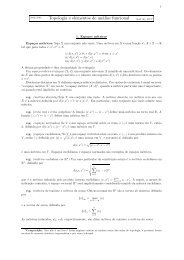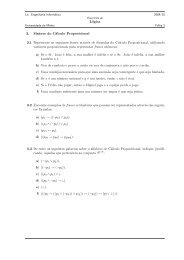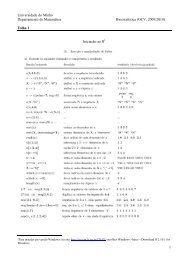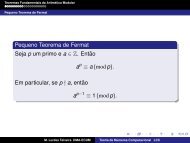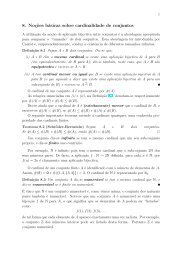My title - Departamento de Matemática da Universidade do Minho
My title - Departamento de Matemática da Universidade do Minho
My title - Departamento de Matemática da Universidade do Minho
You also want an ePaper? Increase the reach of your titles
YUMPU automatically turns print PDFs into web optimized ePapers that Google loves.
10 STATISTICAL DESCRIPTION OF ORBITS 71<br />
As for the ”physical” meaning of this measure, you may imagine that X represents the possible<br />
outcomes when tossing a coin with z si<strong>de</strong>s, and p k is the probability of obtaining the k-th si<strong>de</strong>.<br />
Then points in Σ + represent the outcomes of an infinite sequence of tossings, and the very <strong>de</strong>finition<br />
of µ says that each trial is <strong>de</strong>scribed by the probability p, and each trial is ”in<strong>de</strong>pen<strong>de</strong>nt” from<br />
any finite collection of different trials.<br />
It is not surprising that µ is in<strong>de</strong>ed an invariant probability measure. This comes from the fact<br />
that the inverse image σ −1 (A) of any A ∈ A is the disjoint union of z elements B 1 , B 2 , ..., B z of<br />
the algebra (obtained from A chosing the first letter in z different ways) with measures µ (B k ) =<br />
p k · µ (A), so that<br />
µ ( σ −1 (A) ) z∑<br />
= p k · µ (A) = µ (A)<br />
k=1<br />
Absolutely continuous invariant measures for maps and flows. Let U be a <strong>do</strong>main in<br />
some eucli<strong>de</strong>an R n , and let vol <strong>de</strong>note the Lebesgue measure on U, given locally as dvol = dx =<br />
dx 1 dx 2 ...dx n . A local diffeomorphism f : U → U of class C 1 preserves the measure vol iff<br />
∑<br />
x∈f −1 {x ′ }<br />
1<br />
|<strong>de</strong>t f ′ (x)| = 1<br />
for any point x ′ ∈ U, as one can check using the change of coordinates formula. Also interesting is<br />
to see wheather f preserves an absolutely continuous measure µ = ρvol, and this happens iff the<br />
”<strong>de</strong>nsity” ρ satisfies the equation<br />
∑<br />
x∈f −1 {x ′ }<br />
ρ (x)<br />
|<strong>de</strong>t f ′ (x)| = ρ (x′ )<br />
for any point x ′ ∈ U.<br />
Now, let φ be the flow of a vector field ξ = ∑ n<br />
consi<strong>de</strong>ring the Jacobian of the diffeomorphisms φ t . Since<br />
k=1 ξ k ∂<br />
∂x k<br />
on U. The above obviously applies,<br />
<strong>de</strong>t φ ′ t =<br />
∫ t<br />
0<br />
divξ ◦ φ s ds<br />
we get the result that Lebesgue measure vol is invariant un<strong>de</strong>r the flow of ξ iff<br />
divξ =<br />
n∑<br />
k=1<br />
∂ξ k<br />
∂x k<br />
= 0<br />
In general, the absolutely continuous measure µ = ρvol is invariant un<strong>de</strong>r the flow of ξ iff its <strong>de</strong>nsity<br />
satisfies div (ρξ) = 0.<br />
Hamiltonian flows. Consi<strong>de</strong>r a symplectic manifold (X, ω). Liouville measure dvol = ω n is<br />
invariant un<strong>de</strong>r the Hamiltonian flow of any Hamiltonian function H. If X has finite volume, it<br />
can be normalized to give an invariant probability measure.<br />
Geo<strong>de</strong>sic flows. Consi<strong>de</strong>r a geo<strong>de</strong>sic flow on the unit tangent bundle π : SM → M of the<br />
Riemannian manifold (M, g). Let dvol = √ gdx <strong>de</strong>note the Riemannian volume form on M, and<br />
let dσ m <strong>de</strong>notes the Lebesgue probability measure on the sphere S m M = π −1 {m}. The Liouville<br />
measure µ, <strong>de</strong>fined locally as dvol (m) × dσ m , is invariant un<strong>de</strong>r the geo<strong>de</strong>sic flow.



